Exploring the Transformation in the ‘Spirit of Place’ by Considering the Changed and Unchanged Defensive Spaces of Settlements: A Case Study of the Wugoushui Hakka Settlement
Abstract
1. Introduction
2. Literature Review
2.1. Definitions and Research into ‘Spirit of Place’
2.2. Defensive Spaces of Traditional Settlements
2.3. Relationship between Defensive Space and Spirit of Place
3. Research Methods
3.1. Structured Observation
3.2. In-Depth Interviews
3.3. Content Analysis
3.3.1. Method Introduction
3.3.2. Process
3.4. Site Analysis
4. Analysis and Changes in Wugoushui’s Defensive Space
4.1. Reliability Analysis and Content Analysis
4.1.1. Reliability Score
4.1.2. Content Analysis
4.2. Changes in Wugoushui’s Defensive Space
4.2.1. Changes in Wugoushui’s Spiritual Defences
A1—Fengshui Landscape
A2—Religious Beliefs
A3—Symbols of Physical Defence
A4—Trust
A5—Sense of Belonging
4.2.2. Changes in Wugoushui’s Physical Defences
B1—Topography
B2—Boundary Defences
B3—Access Control
B4—Nodes
B5—Street Network
B6—Planting
4.2.3. Changes in Wugoushui’s Behavioural Defences
C1—Institutions
C2—Social Norm
C3—Territory
C4—Affordance
C5—Social Networks
5. Transformation in Wugoushui’s Spirit of Place
5.1. Wugoushui’s Spirit of Place
5.2. Causes of Changes in the Spirit of Place
6. Conclusions
Author Contributions
Funding
Data Availability Statement
Acknowledgments
Conflicts of Interest
References
- Shafiei, M.; Leardini, P. The spatial functionality of rural spaces to urban needs. Int. J. Interdiscip. Glob. Stud. 2018, 13, 45–60. [Google Scholar] [CrossRef]
- Wu, K.-L.; Jin, M. Exploring the ecological wisdom, genius loci, and multiple values of vegetable cellars in the rural villages of northeast China. J. Archit 2017, 101, 161–184. (In Chinese) [Google Scholar]
- ICOMOS. 2008. Available online: https://www.icomos.org/images/DOCUMENTS/Charters/GA16_Qaimenuebec_Declaration_Final_EN.pdf. (accessed on 16 January 2021).
- Wei, Z. Residents’ collective memory of urban street and lane spaces: A case study of the confucius temple block in Nanjing city. J. Landsc. Res. 2016, 8, 61–72. [Google Scholar]
- Norberg-Schulz, C. Genius Loci: Towards a Phenomenology of Architecture; Rizzoli: New York, NY, USA, 1980. [Google Scholar]
- Petzet, M. The Spirit of Monuments and Sites, 16th General Assembly of ICOMOS, Quebec, Canada, 30 September 2008. Available online: http://www.international.icomos.org/quebec2008/cd/toindex/papers_ouverture/inaugural-Vortrag_Petzet.pdf (accessed on 28 April 2021).
- Rajković, I.; Bojović, M. Revitalization of traditional architecture towards sustainable development of the Skadar lake area. Archit. Urban Plan. 2016, 11, 32–42. [Google Scholar] [CrossRef][Green Version]
- Wang, X. Analysis on the defensive space of traditional fortress settlement. Archit. J. 2003, 4, 64–70. (In Chinese) [Google Scholar]
- Wang, X.; Huang, W.J.; Hou, X. A study on the traditional baozhai settlement in Shanxi. Archit. J. 2003, 8, 59–61. (In Chinese) [Google Scholar]
- Ling, H. A review on the development of spirit of place. Gard. Landsc. 2017, 14, 274. (In Chinese) [Google Scholar]
- He, Y.F.; Chen, C.P. A literature review of the traditional settlement defensive space. J. Des. Sci. 2019, 22, 61–84. (In Chinese) [Google Scholar]
- Law of Cultural Assets Preservation. Available online: https://law.moj.gov.tw/LawClass/LawAll.aspx?PCode=H0170001 (accessed on 16 January 2021).
- Hung, J.T. Genius Loci Probing into the Spatial History of the Rural Settlements in Taiwan—A Study on Rihnan. Master’s Thesis, Dayeh University, Taichung, Taiwan, 2006. (In Chinese). [Google Scholar]
- Liang, Y.Y. The Configuration of Beipu Hakka Settlements in the Late Qing Dynasty; Cultural Affairs Bureau of Hsinchu County Government: Hsinchu, Taiwan, 2000. (In Chinese)
- Public Data of Wugoushui. Available online: https://nchdb.boch.gov.tw/indigenous/assets/overview/groupsOfBuildings/20080519000001 (accessed on 26 January 2021). (In Chinese)
- Chu, Y.C.; Hsu, M.F.; Hsieh, C.M. A field assessment on natural ventilation and thermal comfort of historical district—A case of the Wugoushui settlement in Taiwan. J. Earth Sci. Eng. 2015, 5, 463–472. [Google Scholar]
- Lee, C.C.; Chen, Y.X.; Wu, Y.L.; Yeh, W.C.; Liang, C.M. Multilevel analysis of the pressure of agricultural land conversion, degree of urbanization and agricultural land prices in Taiwan. Land 2020, 9, 474. [Google Scholar] [CrossRef]
- He, Y.F.; Chen, C.P.; Chou, R.J. The key factors influencing safety analysis for traditional settlement landscape. Sustainability 2019, 11, 3431. [Google Scholar] [CrossRef]
- Zhou, X.D.; Shen, Y.; Xiao, F. From object to field: A strategy for cultural landscape protection and integration. Chin. Landsc. Archit. 2011, 27, 4–9. (In Chinese) [Google Scholar]
- Tan, H.L.; Ye, B.J. Research on the central exterior space of traditional village in southern Fujian based on the spirit of place. Urban. Archit. 2020, 17, 133–136. (In Chinese) [Google Scholar]
- Brook, I. Can ‘spirit of place’ be a guide to ethical building. In Ethics and the Built Environment; Fox, W., Ed.; Routledge: London, UK, 2000; pp. 139–152. [Google Scholar]
- Tuan, Y.F. Space and Place: The Perspective of Experience; University of Minnesota Press: London, UK, 1977. [Google Scholar]
- Entrikin, J.N. The Betweenness of Place: Towards a Geography of Modernity; The Johns Hopkins University Press: Baltimore, MD, USA, 1991. [Google Scholar]
- Cojanu, D. Homo localis, interpreting cultural identity as spirit of place. Procedia Soc. Behav. Sci. 2014, 149, 212–216. [Google Scholar] [CrossRef]
- Wang, H.J. Spirit of place: The core of landscape design. Art Des. Res. 2007, 4, 10–12. (In Chinese) [Google Scholar]
- Cai, Y.F. The Method Research Built by “Genius Loci” in the Renew Strategy of the German Industrial Inheritance. Ph.D. Thesis, Zhejiang University of Technology, Hangzhou, China, 2016. (In Chinese). [Google Scholar]
- Wang, Q. Meaning of research—Comments on Christian Norberg-Schultz’s architecture theory. World Archit. 1997, 4, 73–77. (In Chinese) [Google Scholar]
- Ling, M.B.Z.; Wu, Y.D. The “ Spirit of Place” and contemporary Japanese architecture. World Archit. 1996, 4, 52–53. (In Chinese) [Google Scholar]
- Chen, Y.X. Introduction and criticism of Norberg Schulz’s “place and place spirit” theory. J. Chang. Univ. 2003, 20, 30–33. [Google Scholar]
- Hall, E.T. The Hidden Dimension; Doubleday: New York, NY, USA, 1966. [Google Scholar]
- Jacobs, J. The Death and Life of Great American Cities; Vintage: New York, NY, USA, 1961. [Google Scholar]
- Hu, Z.Z. Human Geography; Sanmin Press: Taipei, Taiwan, 1977. (In Chinese) [Google Scholar]
- Wang, X.; Hou, X. Study on the category of traditional stockaded village in Shanxi. Hum. Geogr. 2006, 6, 35–39. (In Chinese) [Google Scholar]
- Wei, J.; Wang, Y.P.; Wang, Y. Analysis on the defensibility of tunpu settlements and buildings in Anshun, Guizhou province. Huazhong Archit. 2010, 28, 157–160. (In Chinese) [Google Scholar]
- Zhang, K.Y.; Song, K. The research of li fang system and bao in pingyao shanxi. Architect 1996, 4, 50–54. (In Chinese) [Google Scholar]
- Wang, X.; Hou, X. Study on the Classification of the Traditional Defensive Settlements. Architect 2006, 2, 75–79. [Google Scholar]
- Wang, F.Z. Urban Crime Space; Southeast University Press: Nanjing, China, 2012. (In Chinese) [Google Scholar]
- Chen, F.; Kong, J.; Zuo, Y. Spatial Characteristics Analysis of Traditional Defensive Settlements: Wangnao Village, Shahe City. Mod. Urban. Res. 2017, 11, 31–37. [Google Scholar]
- Panamanian Fortifications Inscribed on List of World Heritage in Danger. Available online: http://whc.unesco.org/en/news/892 (accessed on 28 January 2021).
- Tuan, Y.F. Topophilia: A Study of Environmental Perceptions, Attitudes, and Values; Columbia University Press: New York, NY, USA, 1990. [Google Scholar]
- Astuti, R. “The Vezo are not a kind of people”: Identity, difference, and “ethnicity” among a fishing people of western Madagascar. Am. Ethnol. 1995, 22, 464–482. [Google Scholar] [CrossRef]
- Jorgensen, B.S.; Stedman, R. Sense of place as an attitude: Lakeshore owners attitudes toward their properties. J. Environ. Psychol. 2001, 21, 233–248. [Google Scholar] [CrossRef]
- Relph, E. Spirit of place and sense of place in virtual realities. Techné Res. Philos. Technol. 2007, 10, 17–25. [Google Scholar] [CrossRef]
- Lin, Z.H. An initial exploration into the relationship between the appearance of “ke” in historical materials and the development of the Hakka tribe. Bull. Acad. Hist. 2006, 10, 1–61. [Google Scholar]
- Liu, P.L. Traditional Settlement Cultural Landscape Gene: Deep Reading on Genetic Map about Traditional Settlements Landscape; The Commercial Press: Hongkong, China, 2014. (In Chinese) [Google Scholar]
- Liu, P.L.; Liu, C.L.; Deng, Y.Y.; Sheng, X.Y.; Hu, Z.; Li, B.H. Study on the identification of hakka traditional village’s landscape genes and analysis in the perspective of geography. Hum. Geogr. 2009, 24, 40–43. (In Chinese) [Google Scholar]
- Maslow, A.H. A Theory of Human Motivation; Simon and Schuster: New York, NY, USA, 2013. [Google Scholar]
- Bailey, K.D. Methods of Social Research, 4th ed.; Free Press: New York, NY, USA, 2007; pp. 241–274. [Google Scholar]
- Rydberg, A.; Ericson, B.; Lindstedt, E. Use of a structured observation to evaluate visual behavior in young children. J. Vis. Impair. Blind. 2004, 98, 172–179. [Google Scholar] [CrossRef]
- Kvale, S.; Brinkmann, S. Interviews: Learning the Craft of Qualitative Research Interviewing; Sage publications: New York, NY, USA, 2009. [Google Scholar]
- Guan, X.S. Design Research Method; Chuan Hwa Publishing Ltd.: Taipei, Taiwan, 2006. (In Chinese) [Google Scholar]
- Krippendorff, K. Content Analysis: An. Introduction to Its Methodology; Sage Publications: New York, NY, USA, 2018. [Google Scholar]
- Krippendorff, K. Validity in content analysis. In Computerstrategien für die Kommunikationsanalyse; Mochmann, E., Ed.; Campus-Verlag: Frankfurt, Germany, 1980; pp. 69–112. [Google Scholar]
- Krippendorff, K. Content Analysis; Barnouw, E., Gerbner, G., Schramm, W., Worth, T.L., Gross, L., Eds.; International Encyclopedia of Communication; Oxford University Press: New York, NY, USA, 1989; pp. 403–407. [Google Scholar]
- Krippendorff, K. Content Analysis: An Introduction to Its Methodology, 3rd ed.; Sage Publications: New York, NY, USA, 2013. [Google Scholar]
- Holsti, O.R. Content Analysis for the Social Sciences and Humanities; Addison-Wesley: Boston, MA, USA, 1969; pp. 602–611. [Google Scholar]
- Wimmer, R.D.; Dominick, J.R. Mass Media Research: An. Introduction, 9th ed.; Cengage Learning: Boston, MA, USA, 2011; p. 175. [Google Scholar]
- LaGro, J.A. Site Analysis: Linking Program and Concept in Land Planning; John Wiley & Sons: Hoboken, NJ, USA, 2001. [Google Scholar]
- LaGro, J.A., Jr. Site Analysis: A Contextual Approach to Sustainable Land Planning and Site Design, 2nd ed.; John Wiley & Sons: Hoboken, NJ, USA, 2008. [Google Scholar]
- Wimmer, R.D.; Dominick, J.R. Qualitative Research Methods; Wadsworth Publishing Company: Belmont, CA, USA, 1993. [Google Scholar]
- Chiou, Y.J. Wugoushui Wetland: A Study of the Physical Environment of a Liuk Tui Hakka Settlements. Master’s Thesis, TungHai University, Taichung, Taiwan, 1989. (In Chinese). [Google Scholar]
- Du, S.C. From tribes to society-as-a-whole: Democratic elections at township level and the mode of generalized trust in rural China. J. Soc. Dev. 2017, 4, 125–147, 240. [Google Scholar]
- Chang, H.B.; Chang, W.A.; Lee, L.S. The belief in god, human relations and social organization: Penang Tanjong Tokong Thai Pak Koong and its ritual organizations. Glob. Hakka Stud. 2014, 3, 111–138. (In Chinese) [Google Scholar]
- Wang, P.F.; Ho, M.C. To explore the model for designing the field of sacred space. J. Des. 2012, 17, 21–44. (In Chinese) [Google Scholar]
- Geng, H.; Zhou, Z. Research on public space of traditional village influenced by folk-custom: Case study of villages in Tunpu of Guizhou. Huanzhong Archit. 2010, 28, 96–99. (In Chinese) [Google Scholar]
- Peng, Y.G. Landscape Analysis of Traditional Villages and Towns; China Architecture and Building Press: Beijing, China, 1994. (In Chinese) [Google Scholar]
- Xing, G.R.; Xu, Y.L.; Zheng, Y. Rural settlement spatial evolution types and features in the process of urbanization. Econ. Geogr. 2007, 27, 932–935. (In Chinese) [Google Scholar]
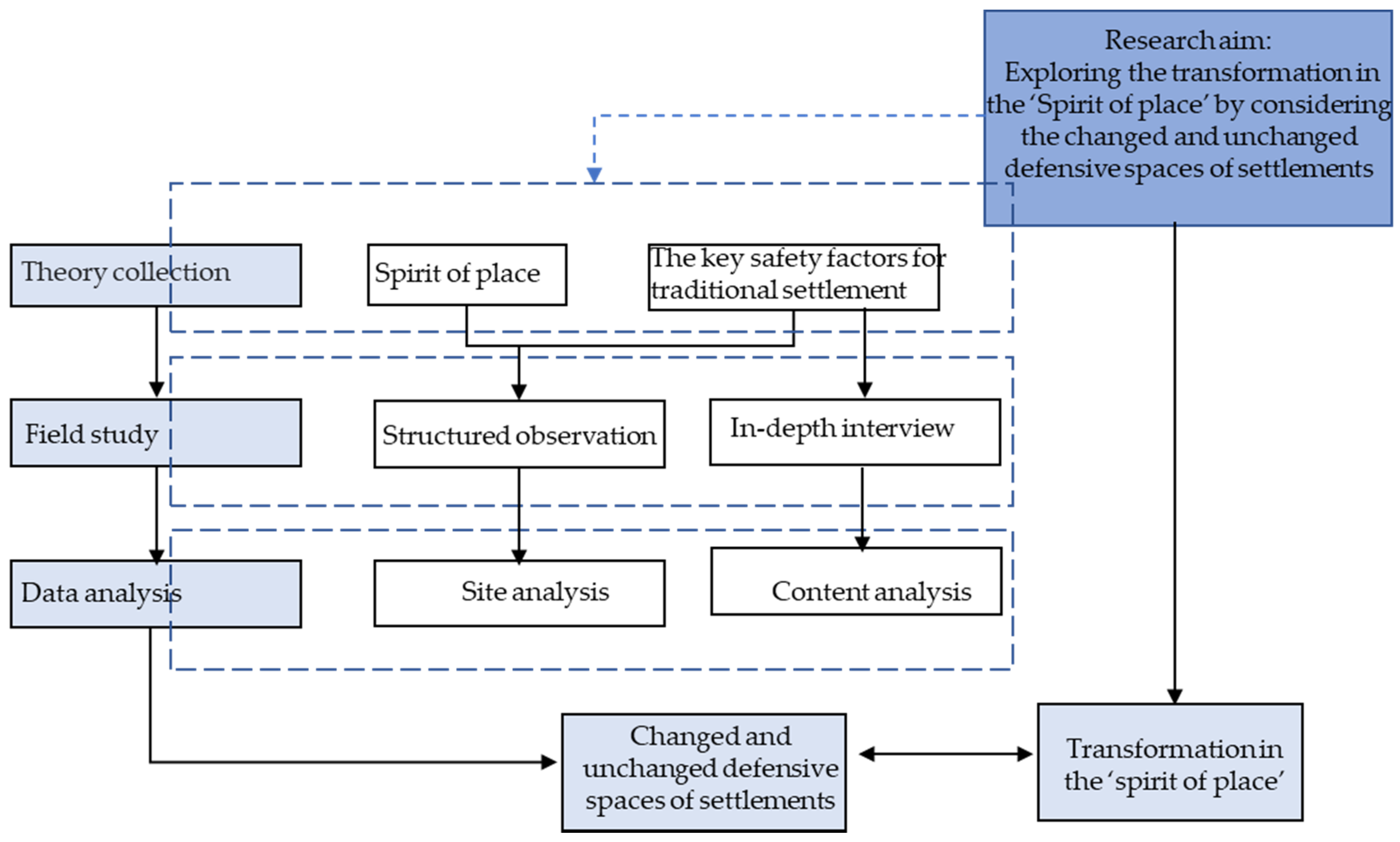
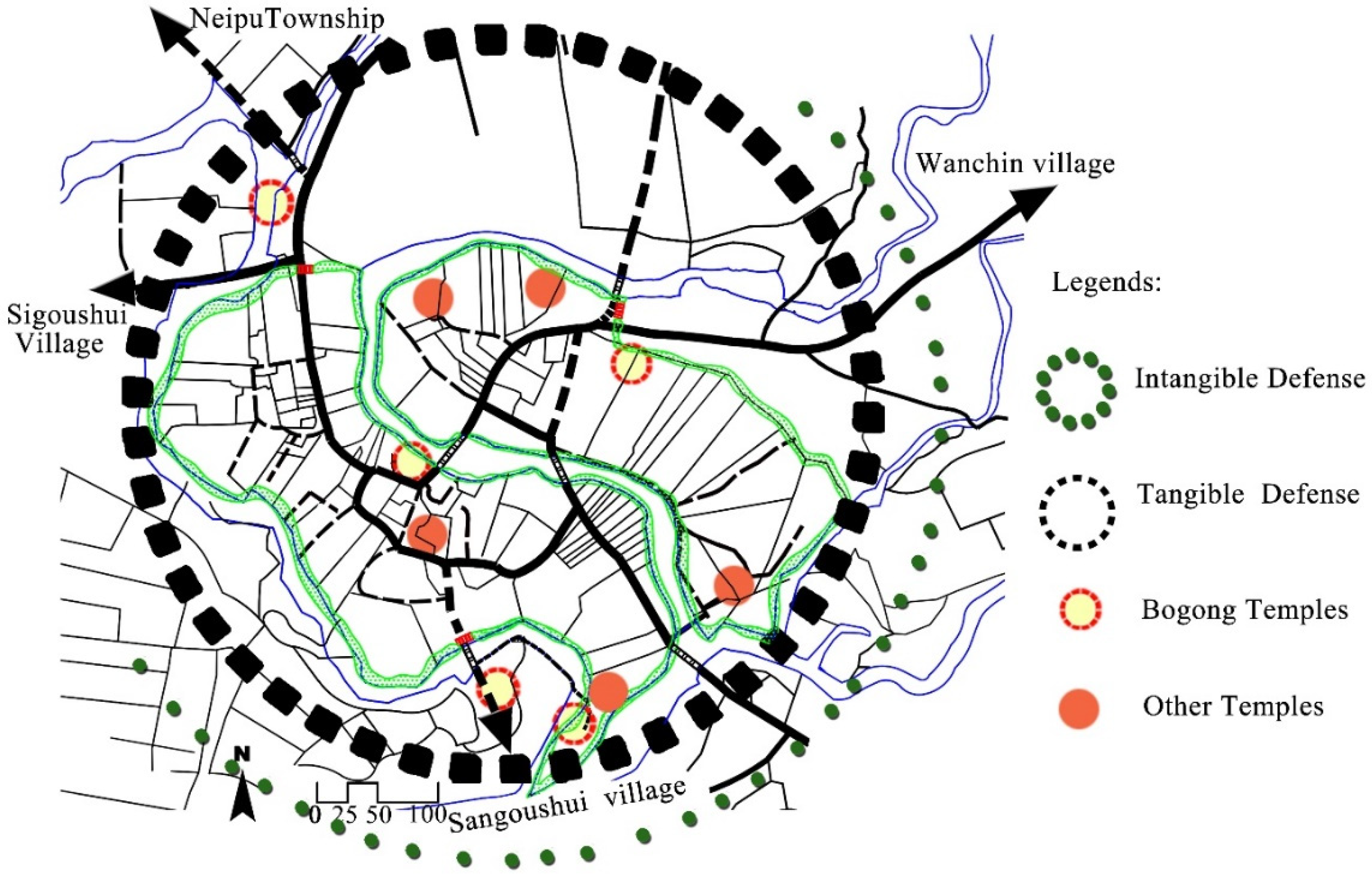
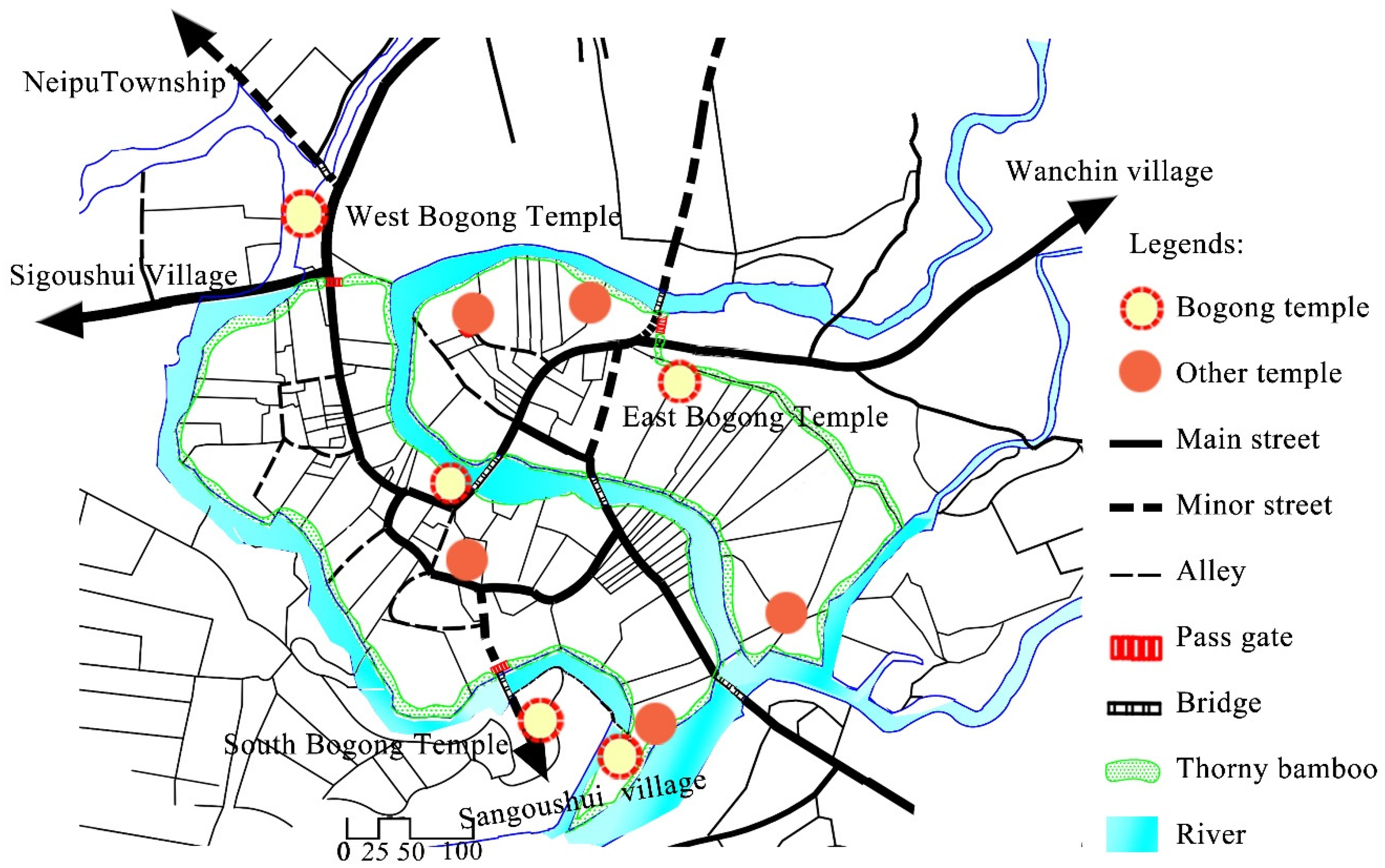
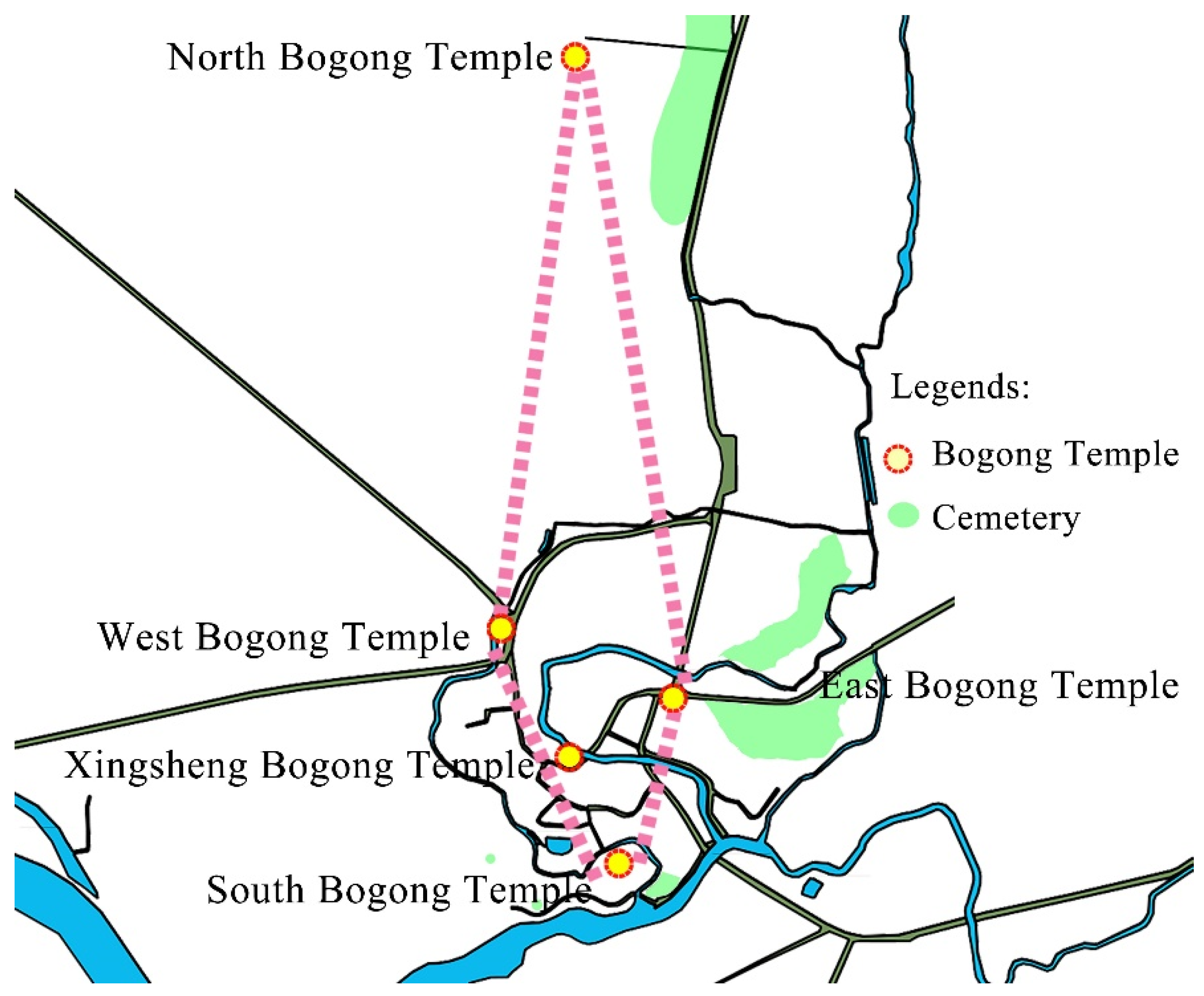
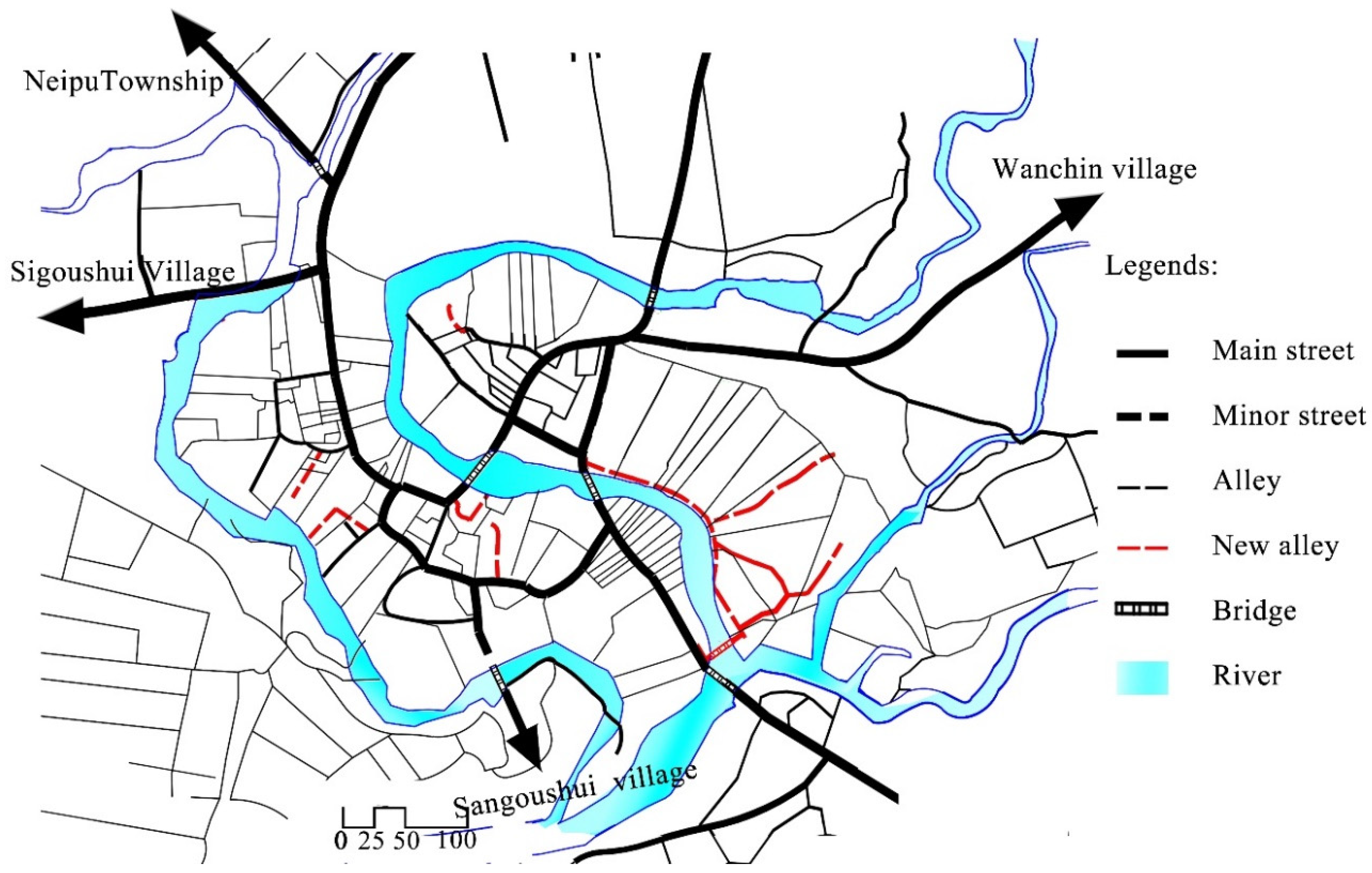
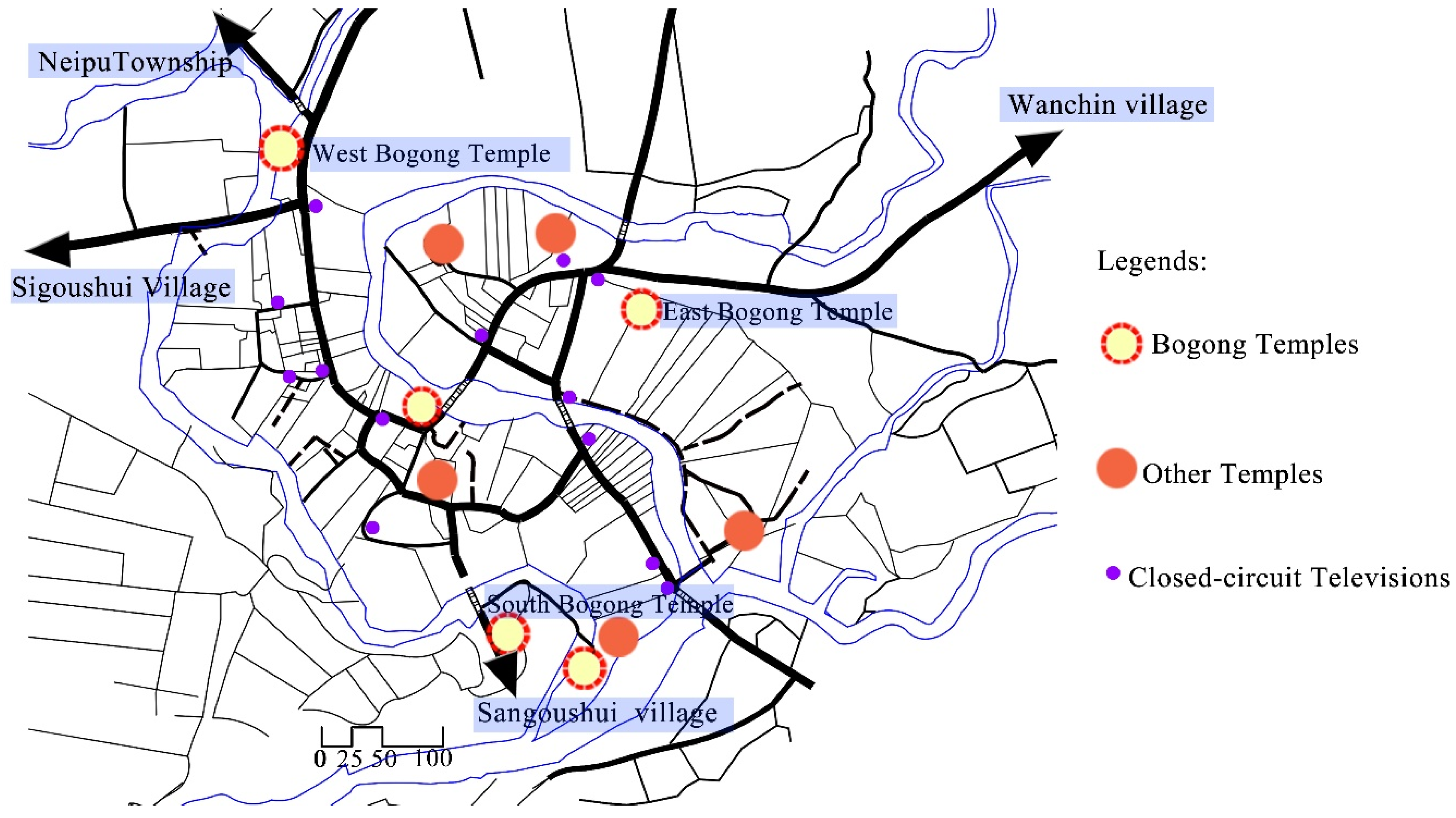
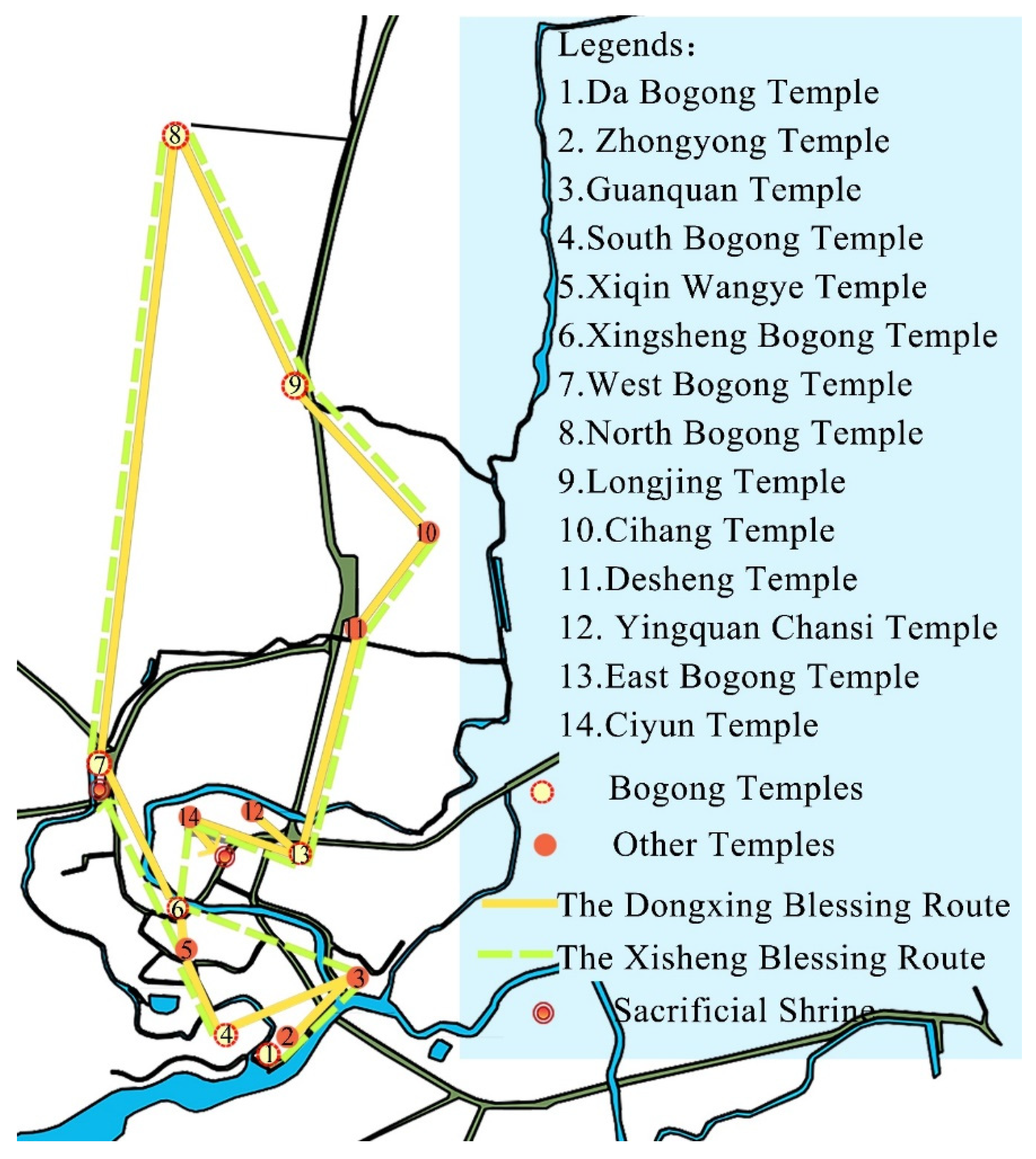
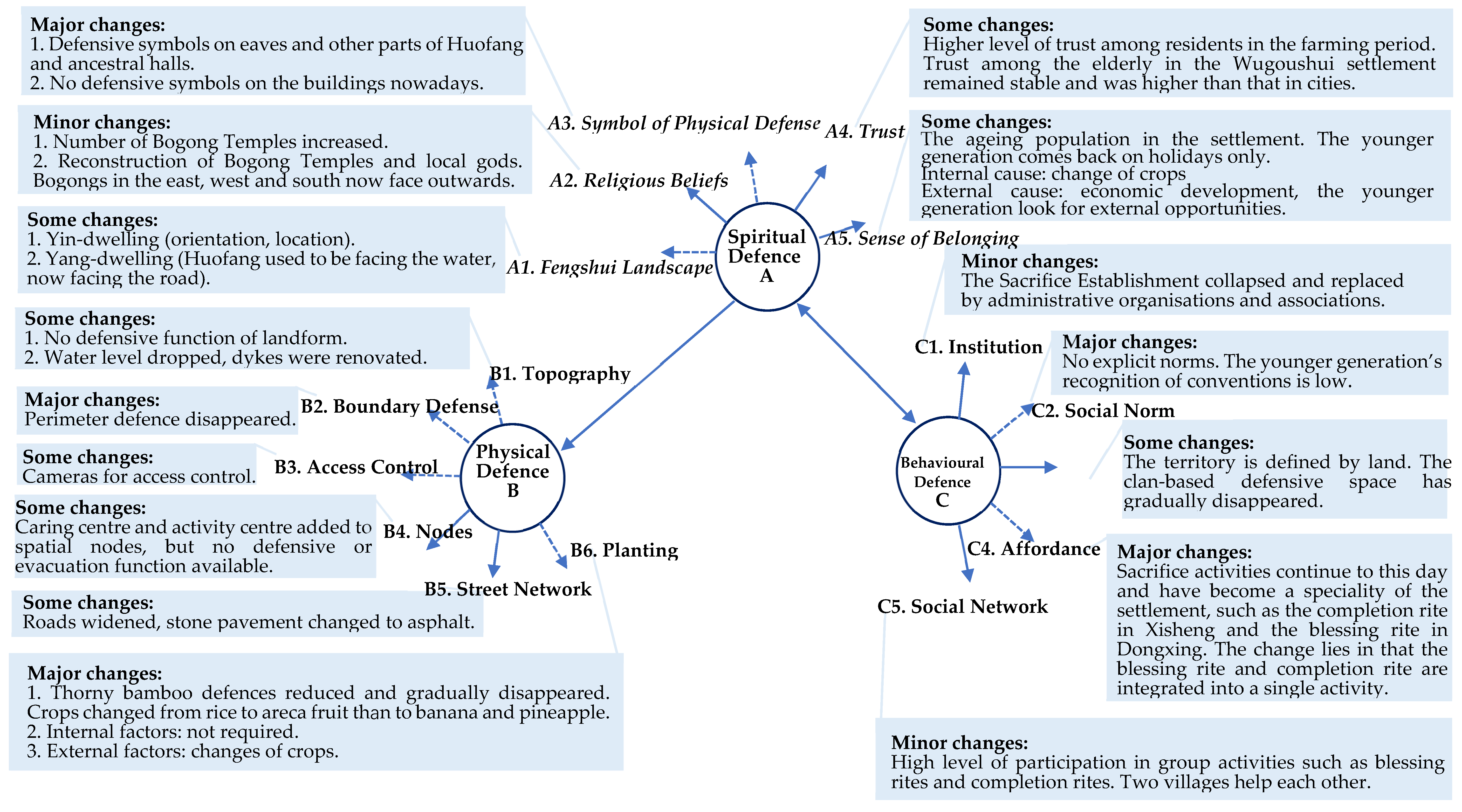
| Aspects | Criteria | Themes |
|---|---|---|
| Spiritual defence (A) | Fengshui Landscape(A1) | 1.Blocking intruding enemies; 2. Blessings; 3. Modern Yang/Yin-dwellings’ lower Fengshui dependence and lower defensive roles. |
| Religious Beliefs (A2) | 1. Praying for peace; 2. Deterring foreign enemies. | |
| Symbol of Physical Defence (A3) | 1. Warning foreign enemies; 2. Providing mental comfort; 3. No defensive symbols on new buildings. | |
| Trust (A4) | 1. Resisting foreign enemies in an untied way; 2. Promoting mental security; 3. Declining trust. | |
| Sense of Belonging (A5) | 1. Reinforcing attachments to the homeland; 2. Enhancing the awareness of defending the homeland; 3. Strengthening united resistance against intrusion. | |
| Physical defence (B) | Topography (B1) | 1. Living along the river; 2. Making the settlement safer. |
| Boundary Defence (B2) | 1. Physical defence roles in early days; 2. Boundaries defined with bridges and stone tablets; 3. No defensive function. | |
| Access Control (B3) | 1. Pass gates at entrances as a defence; 2. Entrances remain unchanged nowadays; 3. The defensive function disappears. | |
| Street Network (B4) | 1. Defensive function of narrow roads; 2. Roads are widened, pavements are upgraded; 3. The defensive function of roads disappears. | |
| Nodes (B5) | 1. Defensive facilities in ancestral halls, temples or houses to fight intruders; 2. Activity centres, caring centres, etc. added to the list of nodes; 3. The defensive function of nodes disappears. | |
| Planting (B6) | 1. Thorny bamboos have almost disappeared nowadays; 2. Changed to river bank defence; 3. Defensive function of stopping intruders. | |
| Behavioural defence (C) | Institution (C1) | 1. Providing human resources for defence; 2. Providing material and financial support for defence; 3. The defensive function gradually disappears. |
| Social Norm (C2) | 1. Conventional norm (unwritten codes and practices) to warn intruders; 2. The standard defensive function has gradually disappeared. | |
| Territory (C3) | 1. Natural boundaries define the defensive space; 2. Human-built boundaries define the defensive space; 3. The defensive function of boundaries has gradually disappeared. | |
| Affordance (C4) | 1. Enhancing collaboration; 2. Less participation in activities; 3. Improving cohesion; 4. Good for resist foreign enemies. | |
| Social Network (C5) | 1. Improving cohesion; 2. Good for resisting foreign enemies. |
Publisher’s Note: MDPI stays neutral with regard to jurisdictional claims in published maps and institutional affiliations. |
© 2021 by the authors. Licensee MDPI, Basel, Switzerland. This article is an open access article distributed under the terms and conditions of the Creative Commons Attribution (CC BY) license (https://creativecommons.org/licenses/by/4.0/).
Share and Cite
He, Y.; Chen, C.-P.; Chou, R.-J.; Luo, H.; Hou, J.-S. Exploring the Transformation in the ‘Spirit of Place’ by Considering the Changed and Unchanged Defensive Spaces of Settlements: A Case Study of the Wugoushui Hakka Settlement. Land 2021, 10, 490. https://doi.org/10.3390/land10050490
He Y, Chen C-P, Chou R-J, Luo H, Hou J-S. Exploring the Transformation in the ‘Spirit of Place’ by Considering the Changed and Unchanged Defensive Spaces of Settlements: A Case Study of the Wugoushui Hakka Settlement. Land. 2021; 10(5):490. https://doi.org/10.3390/land10050490
Chicago/Turabian StyleHe, Yanfeng, Chie-Peng Chen, Rung-Jiun Chou, Haifeng Luo, and Jing-Shoung Hou. 2021. "Exploring the Transformation in the ‘Spirit of Place’ by Considering the Changed and Unchanged Defensive Spaces of Settlements: A Case Study of the Wugoushui Hakka Settlement" Land 10, no. 5: 490. https://doi.org/10.3390/land10050490
APA StyleHe, Y., Chen, C.-P., Chou, R.-J., Luo, H., & Hou, J.-S. (2021). Exploring the Transformation in the ‘Spirit of Place’ by Considering the Changed and Unchanged Defensive Spaces of Settlements: A Case Study of the Wugoushui Hakka Settlement. Land, 10(5), 490. https://doi.org/10.3390/land10050490







